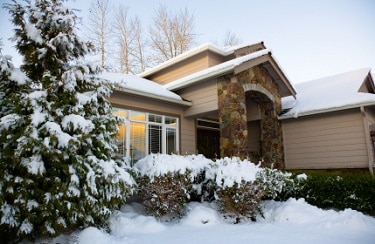Saving Money with Energy-Efficient Landscaping, Part 2: Windbreaks

If you’re going to have some landscaping done to your home, there are a few things you can do to beautify your environment that can also increase the energy efficiency of your home and help you reduce utility bill costs.
For part two of our tips for energy-efficient landscaping, we’re taking a closer look at how incorporating windbreaks can defend against wind chill and help you start saving money on heating costs. In case you missed it, check out part one, where we explored how to use shading techniques to reduce solar heat gain and help you start saving money on cooling costs.
What is a Windbreak?
A windbreak is a landscaping feature in which trees, bushes, shrubs, walls of vines, and even fences are planted or constructed in such a way as to provide your home with protection from the wind. In cold climates, wind chill that cools the outside of your home namely your roof, walls and windows can radiate into your home, or blow in through cracks, and increase heating costs significantly.
How Does a Windbreak Work?
As the wind blows against a windbreak, air pressure builds up on the windward side, or the side of the windbreak facing the wind. The air pressure causes wind speed to slow as large volumes of air are forced to move up, over and around the windbreak. As a result, wind speed is lowered on both the windward and leeward side (the side facing away from the wind) of the windbreak. However, the wind speed on the leeward side of the windbreak is lowered for a much greater distance, creating a warmer microclimate area.
The Benefits of Windbreaks
In short, a windbreak can lower the wind chill near your home. Wind chill happens when the speed of the wind lowers the relative temperature of the air and, although wind chill always lowers temperatures even in moderate climates it’s most prominent on cold, breezy days.
For example, if the outside air temperature is 10 degrees and the wind is blowing at 20 miles per hour, the wind chill will lower the relative temperature to minus-24 degrees. That 34-degree difference can wreak havoc on a home’s heating costs. However, properly designed or constructed windbreaks can be used as barriers to reduce and redirect wind and modify the microclimate in the sheltered area.
How to Design an Effective Windbreak
Various factors of the windbreak structure determine the size and effectiveness of the microclimate area that’s created, including height, density, location, and construction.
Windbreak Height
The height of the windbreak is the most important factor in determining the size of the microclimate area. Depending on the density of the windbreak, wind speed can be reduced on the windward side by a distance equal to 2 to 5 times the height. On the leeward side (downwind) wind speed can be reduced by a distance up to 30 times the height. For example, a row of 15-foot trees can reduce wind speeds up to 45 feet on the windward side and up to 300 feet on the leeward side.
Windbreak Density
The density of the windbreak, whether it’s low-density deciduous trees or the 100-percent density of a solid fence, plays a critical factor in determining how much wind speed is lowered. If your windbreak density is too high, low pressure develops on the leeward side and pulls air coming over the windbreak downward, which creates turbulence and reduces downwind protection. On the other hand, lower-density windbreaks create less turbulence and provide greater protection downwind in terms of microclimate size, but reduce wind speeds less.
The ideal windbreak density for most homeowners is somewhere in the middle, and can usually be achieved by using a combination of deciduous trees (25-35 percent density), coniferous trees (40-60 percent density), bushes and shrubs.
Location and Construction
The best windbreaks for homes will usually follow these guidelines:
– Plant one or more rows of trees and shrubs with low crowns (leaves and branches) to block wind close to the ground.
– Plant dense evergreen trees and shrubs to the north and northwest of homes.
– Plant trees, bushes, and shrubs are together to block wind from ground level to treetops.
– Evergreen trees combined with a fence or wall can deflect wind over the tops of homes.
– Low shrubs can be planted on the windward side of a windbreak to block snow from blowing next to a home where it can cool one or more walls.
Sources
Energy Savers website, Landscape Windbreaks.
United States Department of Agriculture Natural Resource Conservation Service report, How Windbreaks Work.



